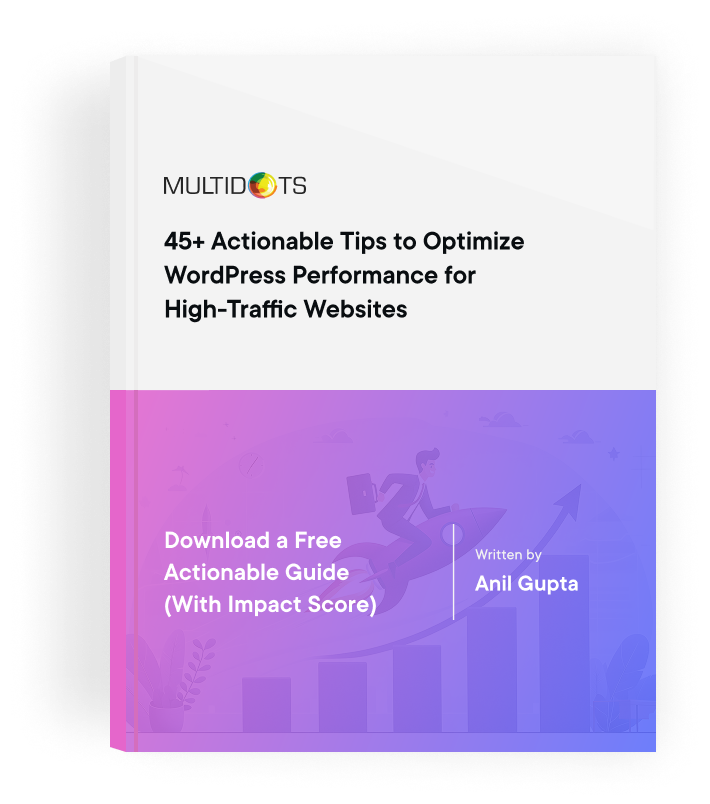Sanity vs WordPress: Which CMS is Best for Your Business?
Compare Sanity and WordPress to determine which CMS aligns best with your business goals and requirements
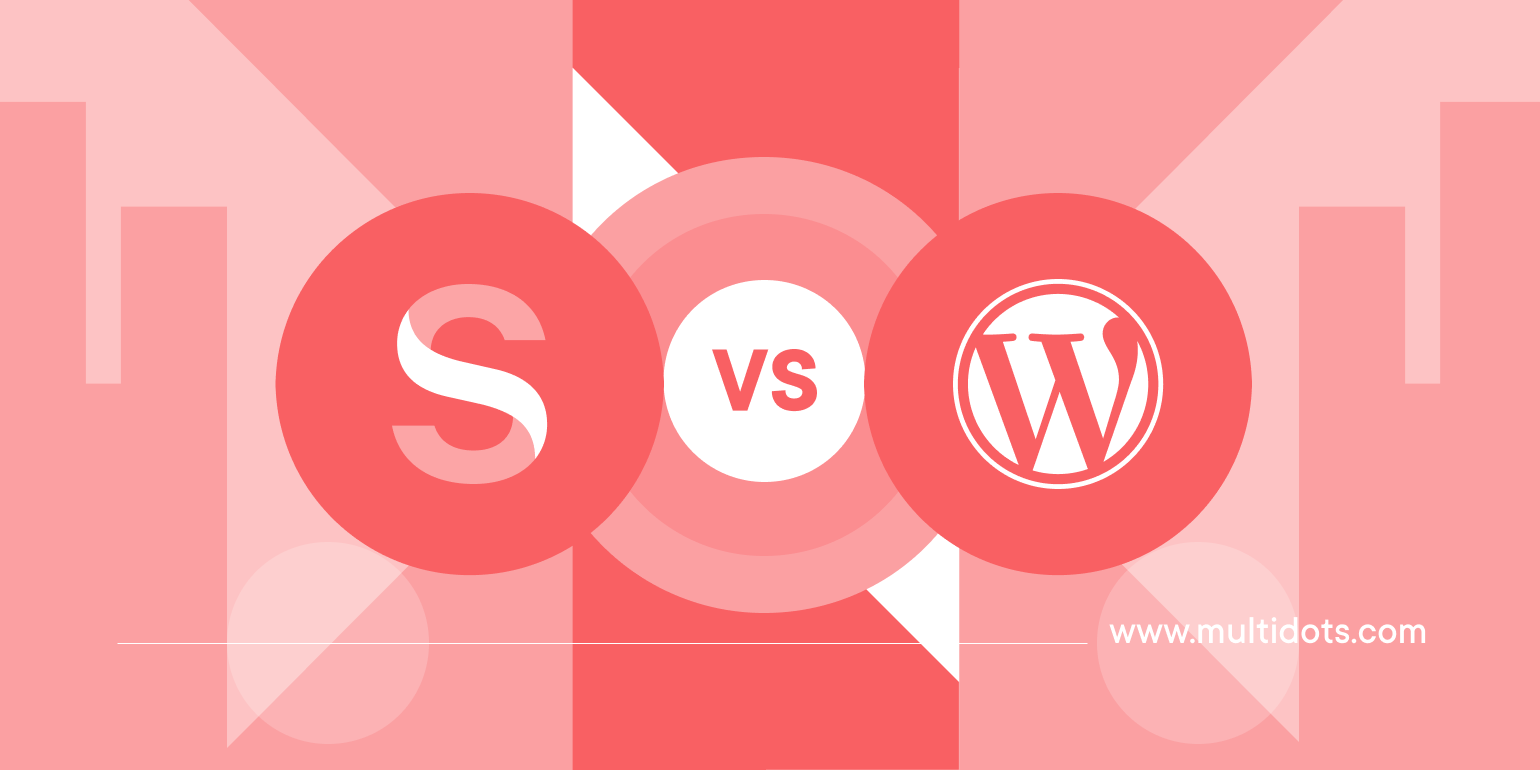
Table of Contents
Choosing the right CMS for your business is a bit like picking a new team member. You want something (or someone) flexible, powerful, and a perfect fit for your team's needs.
In the world of content management systems, WordPress is like the experienced all-rounder who’s been on the scene forever, while Sanity is the new hotshot with some neat tricks up its sleeve. Let's dive into what makes each of them stand out, and perhaps find the best match for your squad.
What is Sanity?
Sanity markets itself as a headless solution in the CMS arena, aiming to provide a Composable Content Cloud. This platform is akin to a toolkit for assembling a different digital infrastructure to each user's specifications. However, unlike WP, Sanity operates on a subscription basis — which might limit its access, particularly for businesses looking for a more open and adaptable platform. It promotes features such as real-time collaboration and a content as data approach through GROQ, its proprietary query language, presenting itself as an API-first platform. While it appeals to those in search of a highly customizable system, it often requires a tech-savvy approach to fully leverage its potential, catering to enterprises focused on custom-built integrations.
BRANDS USES SANITY

What is WordPress?
WordPress, a veteran in the CMS sphere, has cemented its reputation as a reliable and powerful platform since its inception in 2003. WordPress thrives as an open-source platform, allowing it unlimited flexibility and customization without the constraints of a subscription-based model. Its real strength lies in its remarkable flexibility, ease of use, extensive community support, and a vast selection of themes and plugins that empower businesses to effortlessly deploy and manage everything from blogs to complex e-commerce and enterprise sites. WordPress stands out for delivering an all-inclusive, user-friendly experience, making it the preferred choice for businesses seeking a proven, adaptable, and continuously evolving web solution.
BRANDS USES WORDPRESS

Sanity vs WordPress Overview
At its core, Sanity is a fully customizable, headless CMS built for real-time collaboration. It’s designed to deliver content as data over APIs for any channel, device, or product. In contrast, WordPress is the world's most popular CMS, known for its ease of use, versatility, and extensive plugin ecosystem. WordPress powers everything from blogs to full-fledged enterprise websites.
Why Choose WordPress over Sanity?
While Sanity offers cutting-edge, headless capabilities for projects with unique or evolving needs, WordPress brings scalability paired with simplicity and a vast support network. Its extensive theme and plugin library make starting and growing your website accessible to everyone, not just developers. For businesses seeking a balance of power, flexibility, and user-friendliness, WordPress often stands out as the go-to choice.
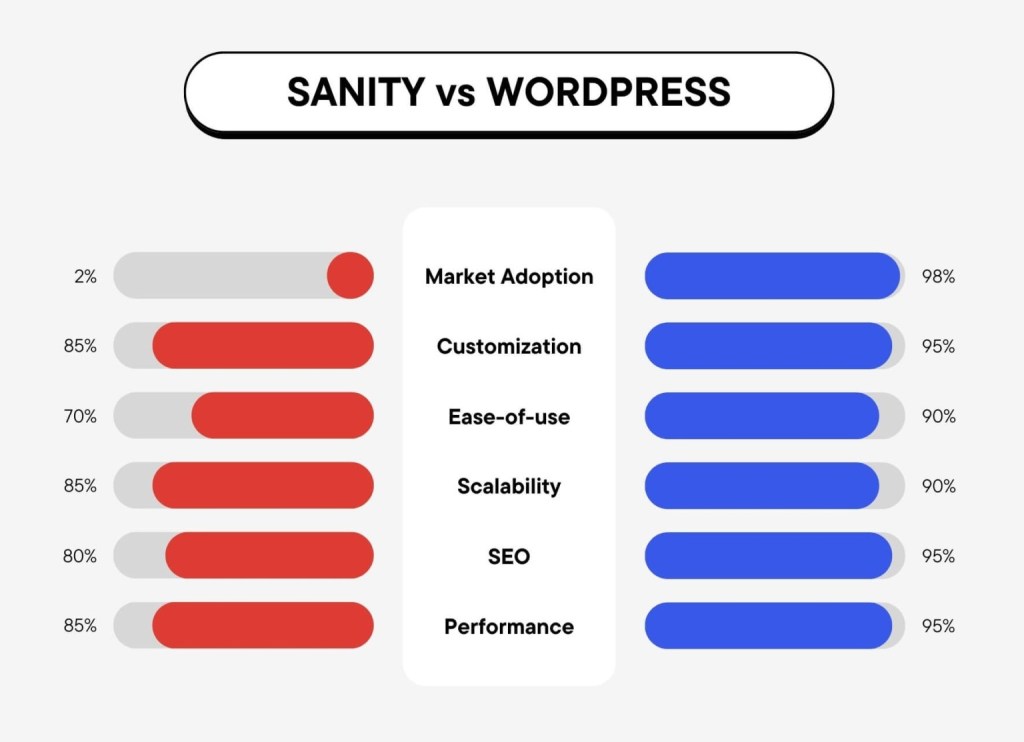
Usage Trends of Sanity vs WordPress
Comparing Sanity and WordPress in terms of usage reveals a stark difference in market presence and application. Currently, WordPress is a market leader, highly favored for its ease of use, reliability, and feature-rich platform that meets various large-scale business demands. Its dominance is a testament to its adaptability and robust community. Sanity, while growing in adoption, caters more to projects requiring bespoke solutions.
Based on the latest data available, Sanity is currently used by around 11,000 websites, while WordPress is powering over 63.3M+ websites (that’s over 43% of all the websites on the web).
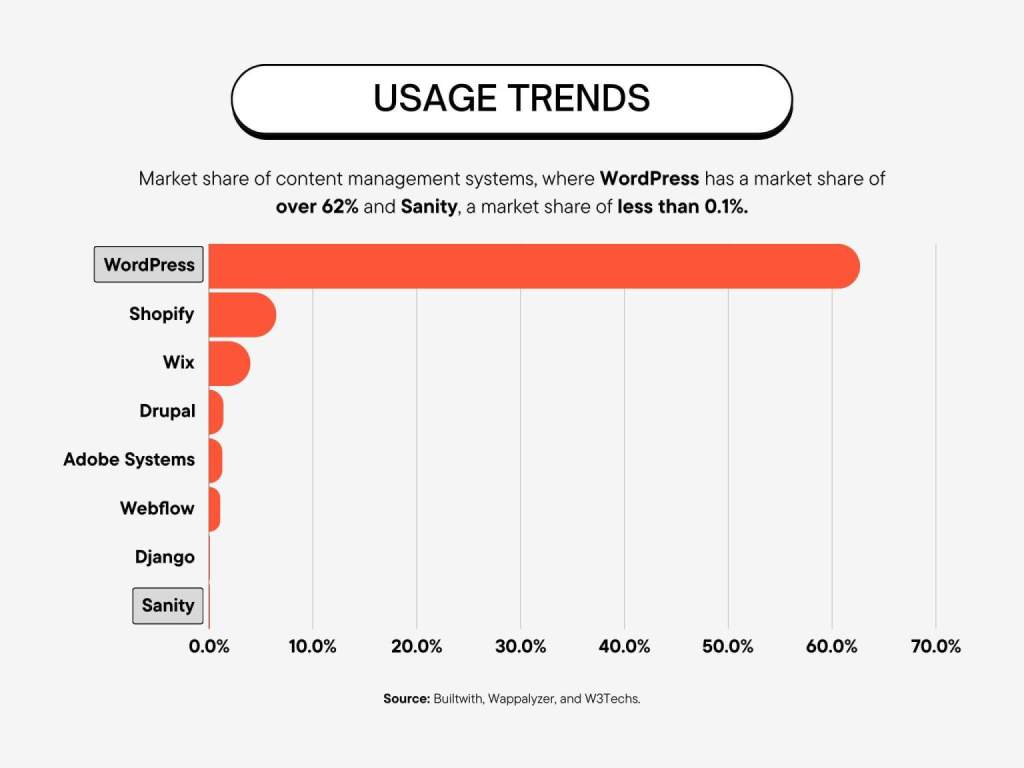
The Qualities of an Ideal Enterprise CMS Solution
For a business, particularly an enterprise settling on a CMS isn't just about publishing content. You need a powerhouse – a platform that's secure, customizable, and scales as you grow. Here's what to look for:
- Ease of Use: It should be easy for your team to create, edit, and publish content without calling IT for help every time.
- Flexibility: Can it grow with your business? Your CMS should adapt to your needs, not the other way around.
- Security: With cyber threats on the rise, a secure platform is non-negotiable.
- Support and Community: When you hit a bump, it's essential to have a support system, whether through official channels or a large community.
- Integrations: Your CMS should play well with other systems (e.g., CRM, e-commerce, etc.), allowing for a seamless workflow.
- Performance: Your website's speed affects user experience and SEO. A good CMS helps keep your site fast.
- SEO-Friendly: It should include features or plugins to help optimize your site for search engines.
In our next sections, we'll see how Sanity and WordPress measure up using these metrics.
Quick Comparison of Sanity vs WordPress
Let's briefly compare the two CMS platforms across key aspects:
| WordPress | Sanity | |
|---|---|---|
| Type of CMS | Complete CMS | Headless CMS |
| Market Adoption | Widely adopted with large community support | Emerging preference among web developers |
| Performance and Scalability | High performance capable of scaling to billions of page views | Designed for real-time updates and high scalability |
| Security | Top-tier security with FedRAMP authorization | Custom security settings, requires setup |
| Ease of Use | Familiar and easy for digital teams | Customizable but with a steeper learning curve |
| Developer Experience | Extensive APIs and integrated workflows | Developer-first with flexible content structures |
| Content Creation and Management | Efficient publishing with Gutenberg editor | Highly customizable, may need developer support |
| Design and Customization | Supports block-based themes and design imports | Offers extensive design flexibility |
| Cost Efficiency | Low total ownership cost | Customizable platform offering potential cost savings |
| ROI and Business Agility | Build once, reuse components, and ensure design consistency | Promotes efficient workflows through customization |
| SEO and Performance | Optimized for SEO and high web performance | Depends on implementation specifics for SEO boost |
| Support and Community | Robust ecosystem of plugins and strong community support | Good developer support, growing ecosystem |
Open-Source vs. Closed-Source Systems: WordPress and Sanity
When evaluating CMS options, the type of system—open-source like WordPress or closed-source like Sanity—plays a critical role in defining flexibility, cost, and control over your digital environment.
WordPress boasts unmatched flexibility due to its open-source nature, allowing extensive customization and broad community support. This platform is ideal for those who require adaptability and on-going improvements with a vast selection of tools powered by a global community.
Sanity, on the other hand, operates on a closed-source, subscription-based model. This provides users with reliability and professional support, albeit at a recurring cost. The closed environment might limit some aspects of customization and depends on the provider for updates and feature improvements.
Evaluating these aspects will help you identify which system best fits your organizational goals, balancing the immediate benefits of a closed-source system with the long-term flexibility of an open-source approach.
Sanity vs WordPress: Full Comparison
When selecting a CMS for your enterprise, it's vital to consider how each option stacks up in various critical areas. Here, we'll examine the significant differences between Sanity and WordPress.
1. Ease-of-use and Setup Process
Sanity prides itself on being a headless CMS that separates the backend from the frontend. This means you have to build your presentation layer from scratch or integrate it with a pre-existing system.
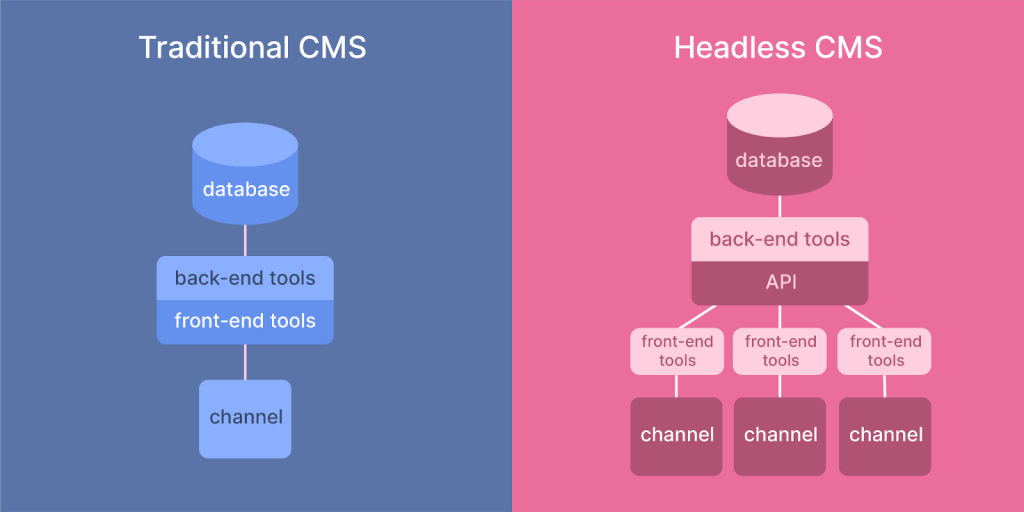
Its setup may involve a learning curve for teams unfamiliar with this approach and requires command-line interaction for initialization. However, it offers a real-time, collaborative studio for content management that's intuitive once in place.
In contrast, WordPress prioritizes ease-of-use with a more traditional CMS approach. It provides a straightforward setup process, enabling your business to get your website up and running swiftly.
With a user-friendly interface that includes a rich visual editor and the ability to manage content effortlessly, WordPress is designed for convenience and accessibility.
2. Customization
Sanity offers immense flexibility for customization, as you can tailor your backend to your exact needs. This allows for a unique fit for specialized business requirements. The trade-off is that it typically demands professional development skills, meaning additional time and resources might be required to shape the platform to your enterprise’s specific demands.
WordPress also offers a high degree of customization, but with a difference. Thanks to a vast selection of themes and a powerful templating engine, non-developers can visually tailor their website with fewer technical hurdles.
For enterprises, this means you can often launch a customized site more quickly with WordPress than with Sanity.
3. Mobile Friendliness
Mobile responsiveness is crucial for modern businesses. Sanity, being API-driven, allows complete control over how content is presented on different devices. Your developers will have the freedom to design a tailormade mobile experience, which can be advantageous for businesses with specific mobile strategy goals.
WordPress acknowledges the mobile-centric world with a responsive admin panel and themes. Most WordPress themes come with mobile-responsive design as a standard feature.
With WordPress, ensuring your site looks good on tablets and smartphones is straightforward, which can be less daunting for businesses wanting to appeal to mobile users quickly and efficiently.
So while both platforms support mobile responsiveness; however, WordPress’s wide selection of mobile-responsive themes makes it easier for businesses to achieve a professional mobile presence without the need for extensive custom development.
4. Team Management
Collaboration is key in enterprise settings. Sanity shines in this space with features like real-time collaborative editing and fine-grained access control. The platform lets multiple team members work on the same document simultaneously, seeing each other's changes as they happen. This is particularly helpful for geographically dispersed teams.
WordPress, while not originally built for real-time collaboration, has made great strides with its block editor (Gutenberg), and plugins that enhance teamwork. User roles and capabilities are built into WordPress, making team management and permission assignments straightforward and robust.
So while Sanity provides excellent tools for real-time collaboration, WordPress’s ecosystem, including plugins for team management, offers a robust and user-friendly solution for managing a team’s digital content efforts efficiently.
5. Plugins and Extensions
Extensibility can significantly enhance a CMS's functionality. Sanity offers plugins, but the ecosystem is considerably smaller when compared to WordPress. Most of the extensions for Sanity are geared towards developers who wish to extend the platform's capabilities.
In contrast, WordPress boasts a vast repository of plugins, with tens of thousands available for nearly any feature your enterprise might require.
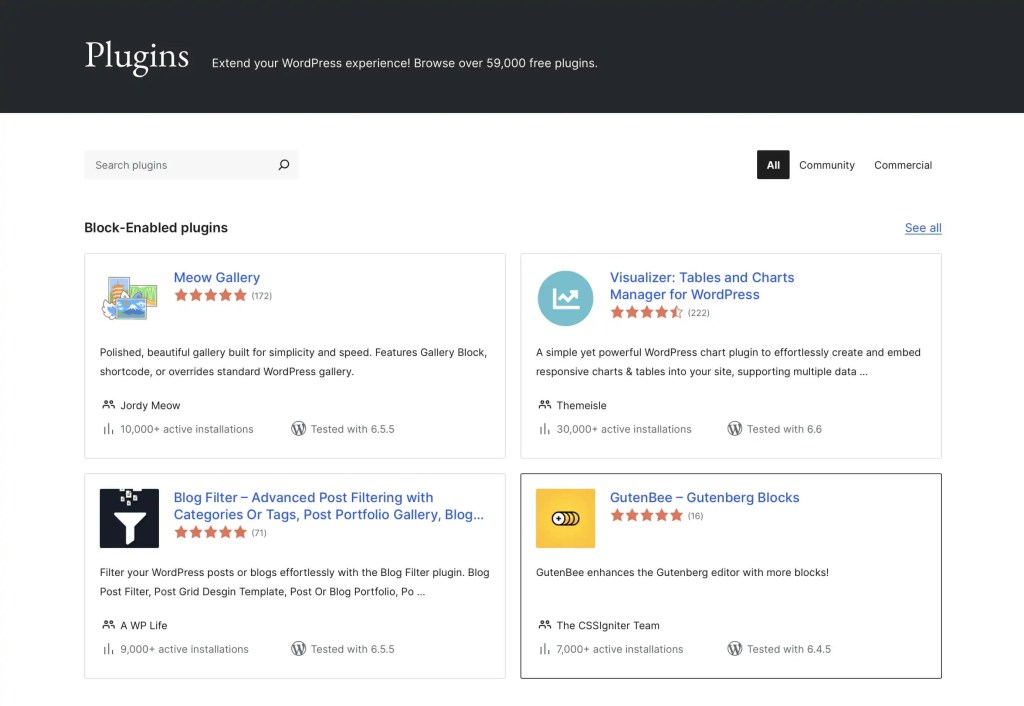
This extensive library enables WordPress to cater to a wide array of business needs without the need to develop custom solutions from scratch.
So while Sanity's plugin ecosystem is growing, WordPress's extensive library of plugins allows businesses to easily expand functionality, making it a preferred choice for companies looking to scale or add specific features quickly.
6. Integrations with Third-Party Services
Sanity offers APIs that facilitate synergies with a wide range of third-party services, from e-commerce platforms to customer relationship management (CRM) tools.
However, the integration process in Sanity is primarily developer-driven, requiring bespoke development to connect and synchronize with these external services.
Conversely, WordPress excels in third-party integrations, supported by a vast array of plugins designed for this purpose. Whether you’re looking to integrate social media, SEO tools, payment gateways, or email marketing services, WordPress likely has several plugin options available.
So WordPress’s vast ecosystem and ease of integration simplifies the process of extending a site's functionality and gives an edge for businesses looking to connect their website with other platforms seamlessly.
7. Security
Security is a top priority for any enterprise. With Sanity, security measures are somewhat dependent on how the enterprise sets up the environment. Being a headless CMS, the separation of the content management system and content delivery allows for a more secure architecture by minimizing the attack surface.
WordPress, while inherently secure, is a more frequent target for hackers due to its popularity. WordPress continuously updates its software to fix vulnerabilities, and there are numerous security plugins available to enhance protection.
Nevertheless, the nature of WordPress means that maintaining security requires regular updates and vigilance, especially with third-party plugins and themes.
Finally, both CMSs offer strong security features; however, WordPress's mature and widespread use equips it with a vast amount of resources and community input for maintaining security, making it a reliable choice for businesses concerned about safeguarding their web presence.
8. Performance Optimization
Performance optimization in Sanity is largely controlled by how the development team structures the application and content delivery.
Being headless, Sanity allows for operations like asset optimization and lazy loading to be custom implemented, enabling highly optimized and fast-loading web experiences.
In contrast, WordPress offers a range of plugins designed to optimize site performance, including caching, image optimization, and script minification.
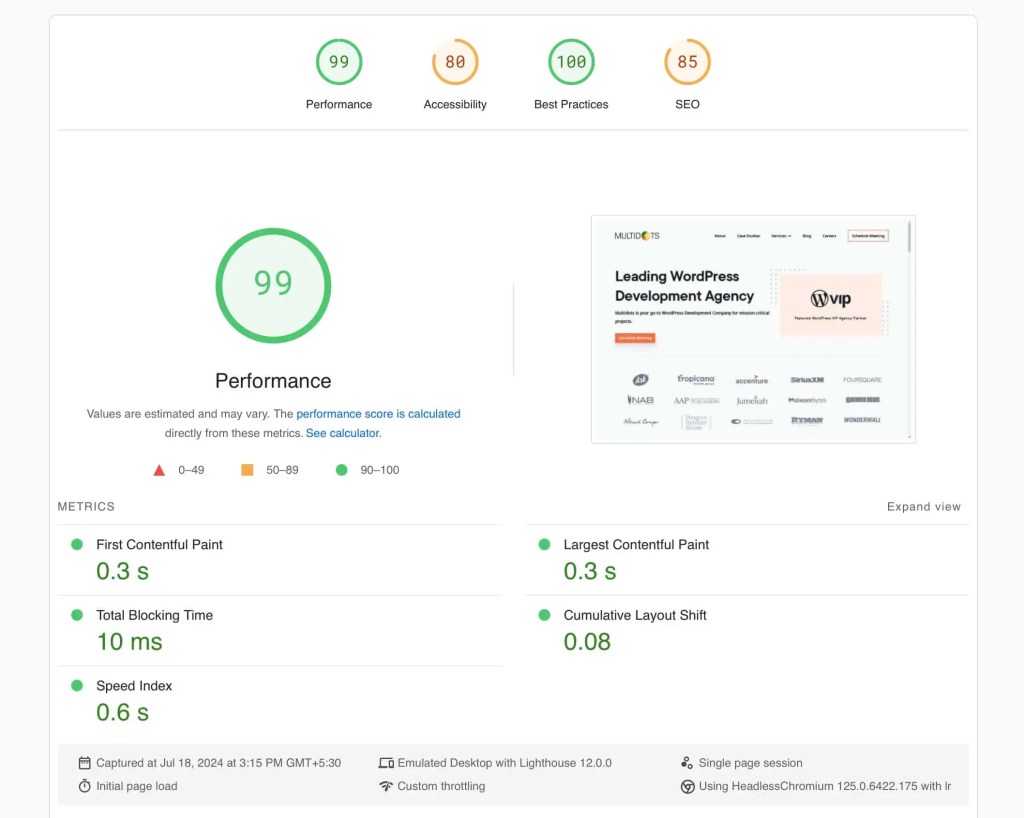
While WordPress provides a solid foundation for good performance, achieving optimal speeds often involves configuring multiple plugins and occasionally custom development work.
Overall, Sanity is built for high scalability and real-time updates, yet WordPress’s performance optimizations and scalability solutions have a proven track record of supporting sites as they grow, offering reliability alongside ease of use.
9. E-commerce Functionality
Sanity can support e-commerce sites but doing so involves integrating with third-party e-commerce platforms via API. This means businesses can create custom e-commerce experiences tailored to their unique needs, but it also requires a significant investment in development to seamlessly integrate these functions.
WordPress, with the help of WooCommerce and other e-commerce plugins, offers a more out-of-the-box solution for setting up an online store.
WooCommerce provides a comprehensive set of e-commerce features, including product listings, cart, checkout, payment processing, and more, all while being highly customizable.
This ease of setting up and managing an online store makes WordPress a go-to choice for enterprises looking to sell online with minimal fuss.
10. Pre-made Themes and Templates
Sanity provides a selection of project templates, which can serve as starting points for various web applications, including personal websites with integrated content editing, agency websites, blogs, and e-commerce stores.
But the templates are fairly limited in their capability and businesses are required to design their user interface from the ground up or utilize third-party frameworks, which can necessitate considerable investments in design and development expertise.
WordPress, on the other hand, provides a massive repository of pre-made themes and templates.
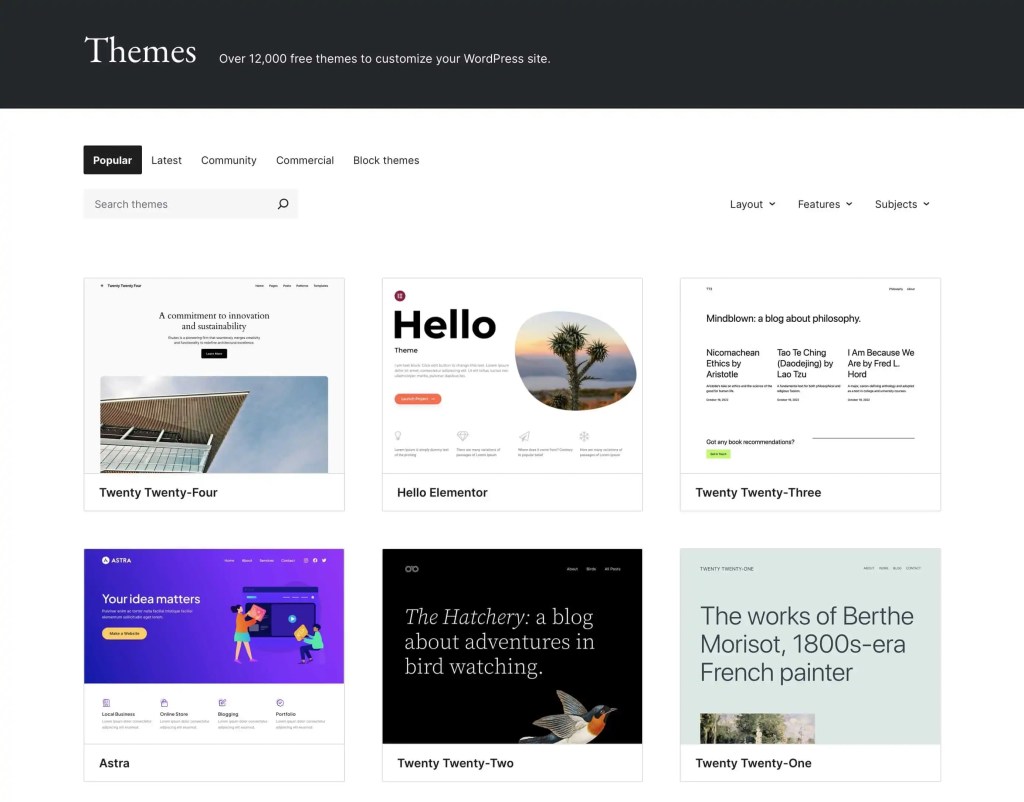
These resources enable businesses to quickly establish a professional web presence.
With themes catering to virtually every industry and purpose, WordPress makes it easy for enterprises to find and customize a look that matches their brand without extensive development.
Which CMS is Best for SEO?
SEO is the bread and butter of online visibility for any business. A CMS that effortlessly blends with your SEO strategies is worth its weight in gold.
WordPress, with its myriad SEO plugins like Yoast SEO, provides a straightforward and effective way to optimize your content. These tools guide you through readability checks, keyword optimization, and offer real-time insights so your content can shine on search engines. WordPress's popularity also means that its SEO capabilities are well-tested in various industries, giving a slight edge in adapting to SEO trends.
On the other hand, Sanity is a newcomer with lots of potential. It's more of a platform that requires you to build your SEO tools or integrate third-party ones. This might mean a steeper learning curve and potentially higher costs as you tailor-make your SEO solutions. However, Sanity's flexibility allows for customized, data-driven approaches that could benefit a niche, SEO-savvy enterprise.
Now, remember that your website's ranking in search engines isn't just about the CMS—it's also about the content quality, website design, and user experience. However, WordPress does offer an easier starting point for businesses aiming to nail their SEO right out of the gate.
Which CMS Offers a Lower Ownership Cost?
The total cost of owning a CMS goes beyond the initial setup—it includes ongoing maintenance, customizations, training, and support.
WordPress urges a strong case for affordability. It's open-source and free to use—you only pay for hosting, themes, and premium plugins. Moreover, thanks to its ease of use, the onboarding process is often less expensive in terms of both time and money.
In contrast, Sanity operates on a pay-as-you-go pricing model, which can climb as your usage scales. Being a headless CMS, the front-end presentation layer is separate, which can lead to increased development costs for businesses aiming for a custom look and functionality tailored to their specific needs.
For enterprises mindful of their budgets, WordPress generally presents a lower total cost of ownership, thanks to its widespread community support and plethora of free resources.
Can WordPress be Used for Enterprise-Level Business?
Absolutely, WordPress isn't just for blogging or small businesses. It's a powerhouse that's scalable enough to support enterprise-level websites. Big brands like Salesforce and Meta have harnessed WordPress for its easy-to-use interface, flexibility, and vast community support.
Enterprises can benefit from its extensive selection of plugins for SEO, security, and social media integration, making it adaptable to various business needs. Furthermore, with a robust hosting service (like WordPress VIP) and the right set of tools, WordPress can handle significant traffic and content loads that large businesses demand.
Additionally, the availability of professional WordPress design and development services means that your enterprise can have a premier-quality website with a tailored strategy for growth. The balance of user-friendliness, extendibility, and a dedicated community makes WordPress a wise choice for businesses planning to scale and evolve with the digital landscape.
Final Verdict: Which CMS is Right for Your Business?
Choosing between Sanity vs WordPress can influence the way your enterprise connects with its audience. Sanity is like a blank canvas — it can be molded to fit any enterprise's specific desires, especially if those needs include handling complex, data-driven content. And because it's headless, Sanity can push content beyond websites to apps, digital displays, and more.
WordPress, on the other hand, offers a vast ecosystem of themes and plugins, which accelerates the development process and allows quick scaling. It's ideal if your business values simplicity, a short learning curve, and a vast community for support.
For enterprises looking for tried-and-true solutions that can be easily managed and customized, WordPress tends to be the go-to choice. However, if your enterprise thrives on a highly bespoke, data-intensive experience, Sanity might be the tool you need, provided you're prepared for the extra resources that may be required.
How Multidots Can Help?
Multidots is an enterprise WordPress solution provider that specializes in implementing complex, high-scale WordPress implementations, migrations, and integrations.
If you are considering WordPress for your CMS, we have the expertise to assist in your platform migration (Sanity to WordPress), performance optimization, and overall website development.
With a team of experienced WordPress engineers and a proven track record with renowned enterprises, you can trust us to deliver mission-critical projects with seamless execution and tangible results.
FAQs
-
WordPress is a traditional, open-source CMS known for its extensive plugin system, themes, and a significant user community. It’s user-friendly and easily adaptable for various website projects. Sanity, however, is a headless CMS designed for structured content that can be delivered across multiple platforms. Sanity offers a customizable editor and real-time collaboration but requires extensive technical knowledge for setup and customization.
-
“Better” is subjective and depends on the project requirements. While WordPress is excellent for a vast range of websites, other CMS like Drupal, Joomla, or headless CMS like Contentful or Sanity may suit specific needs better, such as complex, multi-channel content strategies or when you require extensive customization without relying on plugins.
-
Sanity itself is not an out-of-the-box SEO solution but because it allows for customized content models and API-driven content delivery, it can be optimized for SEO quite effectively when paired with the right tools and practices. The flexibility to manage and deliver content as needed can potentially lead to better SEO performance.
-
Use Sanity CMS if you are looking for a flexible, efficient way to manage content that is not tied to a specific front-end or platform. Its capability for real-time collaboration and its customizable editor can greatly enhance content workflows, especially for content-centric applications that require a headless architecture to push content to multiple screens and devices.
Feel free to schedule a quick call with our migration expert.
Contact Us